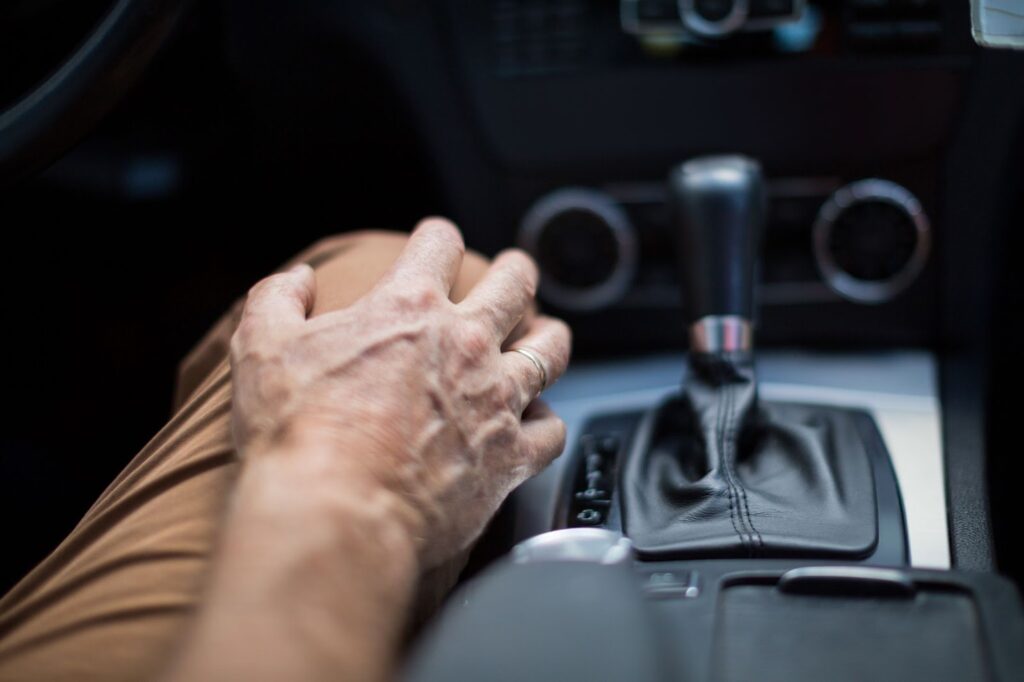
Is knee pain during extended drives really unavoidable, or can we control it more effectively? As a professional driver or passionate traveler, you may believe it’s a typical part of the journey. However, knowing the base reasons and applying the right relief methods can lessen the discomfort.
This dialogue will provide useful advice, physical therapy methods, and preventive actions that could transform your driving journey. Stay tuned, you’re about to learn how to handle extended drives without pain.
Knee Pain Triggers
Comprehending what causes knee pain during driving is important for efficient prevention and treatment. Extended periods of driving can keep your knees in a limited position, leading to strain and discomfort. This is where the importance of driving ergonomics and maintaining knee health comes into play.
Constant acceleration and deceleration require recurring foot movements, potentially leading to patellar tendinitis. This condition can cause inflammation and discomfort. Vibrations from the road can also intensify knee pain, worsening existing knee problems or even causing new ones, especially during long drives.
Improper posture can further worsen knee pain. If a driver doesn’t maintain a correct sitting position, excess pressure can be applied to the knee joints, increasing the likelihood of discomfort. For long-distance drivers, such as truck operators, poor posture can become chronic, resulting in ongoing pain even after leaving the vehicle.
Common Knee Problems During Long Drives
During extended drives, it’s common to encounter knee issues such as continuous pressure on the back of your kneecap and stress on the patellofemoral joint. These challenges often originate from long periods of immobility mixed with the physical demands of operating a vehicle.
A significant aspect contributing to knee discomfort is the alignment of your knee. The position of your knees while driving can influence pressure distribution, potentially leading to pain. Incorrect alignment, often the result of insufficient leg space or uncomfortable driving posture, can worsen pre-existing knee issues or instigate new ones.
Your posture while driving is also influential. If you tend to slouch over the wheel or if your seat isn’t correctly adjusted, it can exert strain on your knees. This strain and the repeated action of pressing pedals can result in persistent pain, a condition often referred to as ‘driver’s knee’.
These problems with the knee are especially common among professional drivers who spend extended hours in the driver’s seat. The effect of knee pain related to driving shouldn’t be overlooked. It can significantly interfere with your ability to drive both comfortably and safely, making those long trips feel even more tiresome.
Alleviating Discomfort: Practical Tips

Easing knee discomfort during car rides involves straightforward, practical steps like making ergonomic changes to your seat and posture, along with effective pain relief techniques. These can do a lot to improve your comfort during long journeys.
Ergonomic Adjustments for Comfort
To ensure comfort during long drives, it’s necessary to make ergonomic adjustments to your car seat and driving position to lessen pressure on your knees and improve overall comfort. Adjusting your seat, such as changing the height or angle, can significantly decrease knee strain.
Ergonomic driving not only helps in preventing pain but also enhances general well-being. Use lumbar support to improve your posture and reduce knee strain. Proper positioning of the steering wheel stops unnecessary reaching and knee movement.
Think about using cushioning or padded seat covers for extra knee support and comfort. Ensure the pedals align with your feet to avoid excessive knee bending. By employing these comfort strategies, you can make the journey as enjoyable as the destination.
Effective Pain Relief Techniques
Utilizing effective pain relief methods can aid in controlling and reducing knee pain during extended drives. Regular stretching and changing your seating position can be beneficial for pain management. Keeping a good posture and using correct lumbar support can lessen discomfort.
Ensure to pause regularly to walk and stretch to avoid stiffness and knee pain. Applying hot or cold packs to your knees can offer substantial relief during these breaks. Knee braces or supports can also be used to steady the knee joint, reducing pain when driving. You can endure long drives without pain by incorporating these strategies into your driving habits.
It is also recommended to wear comfortable shoes that provide adequate support for your feet and knees. Being mindful of your driving habits, such as avoiding sudden braking or excessive acceleration, can help minimize the impact on your knees. By incorporating these additional tips into your driving routine, you can better manage and prevent knee pain while on the road.
Physical Therapy Techniques for Drivers
As a driver, physical therapy can be quite helpful in dealing with knee pain. Approaches such as flexibility exercises, posture improvement, and movements designed for seated therapeutic benefits can result in noticeable betterment.
Let’s examine these techniques and ways to include them in your daily driving routine.
Stretching Exercises for Drivers
Stretching exercises tailored for drivers, especially those that include physical therapy methods, can significantly improve your knee flexibility.
- Active stretches: This type of exercise involves moving parts of your body while gradually increasing reach or speed. It’s an effective pre-driving warm-up.
- Knee extensions: Gently extending and bending your knee can enhance blood flow to the joint.
- Calf stretches: Performing these exercises can prevent muscle tightness that supports your knee.
- Mobility exercises: Regular rotation of your ankles and toe wiggling keeps lower leg muscles active, fostering circulation.
Posture Tips Behind Wheel
Understanding the significance of exercises, we now shift our focus to the correct posture behind the wheel. This, combined with physical therapy techniques, can help avoid knee strain and discomfort during extended drives.
Adjusting your seat properly and providing lumbar support are key steps towards maintaining balance and reducing knee stress. Engage your core muscles while driving to support your lower back and knees, enhancing general comfort during long trips.
Regular breaks are necessary as well. Use these breaks to walk a bit – at leats a couple of rounds around your truck – stretch and correct your seating position, prevent stiffness, and promote better knee health.
Correct posture isn’t only for comfort but also for your overall well-being on those long drives. Let’s drive with consideration for our bodies, together.
In-seat Therapeutic Movements
To help lessen knee discomfort and improve your overall health during travels, here are methods of in-seat therapeutic movements that you, as a truck driver, can undertake during those long drives:
- Chair Yoga: This includes easy yoga movements modified for a seated position. It assists in preserving joint mobility and lessening stiffness.
- Desk Stretches: These are swift, effective stretches aimed at the knee and associated muscles. They speed up blood circulation and prevent muscle tightness.
Chair Yoga: Desk Stretches – YouTube
- Regular Shifting: Modify your sitting position from time to time to avoid knee pressure.
- Leg Extensions: Occasionally, stretch your legs out in front of you, promoting flexibility and comfort.
Prevention Strategies for Knee Pain
A few simple preventative actions can be adopted to enhance your knee health and reduce discomfort during driving. The initial step is to focus on your driving habits. Adjusting your seat correctly is of utmost importance. Good posture lessens the tension on your knees, making long trips less strenuous.
You might want to purchase comfort items like knee cushions or supports. They offer extra comfort and lessen the stress on your knee joints, especially during lengthy drives. The relief they offer can be quite surprising.
Routine knee exercises and stretches are also beneficial. These types of activities can lead to increased flexibility and stronger muscles supporting your knee, offering an extra layer of defense against pain.
Remember to take regular breaks to stretch and move around. This easy habit encourages improved blood circulation, helping to prevent stiffness and ease any existing knee pain.
Last but not least, ensure you drink enough water. This isn’t just beneficial for your overall health and ensures your joints remain lubricated, contributing to their overall wellbeing.
When to Seek Professional Help
Despite your best efforts, there may come a time when your knee pain refuses to go away or worsens, indicating the need for professional medical help. You’re not alone in this situation, and asking for help doesn’t suggest you’re weak. It’s about managing your health and ensuring you can keep doing what you love without constant pain.
Here are four important reasons why immediate action and professional evaluation should be your next steps:
- Immediate action can stop further complications. Neglecting the pain won’t make it vanish. Instead, it can result in more serious health problems in the future.
- A professional diagnosis ensures the correct problem is being treated. Self-diagnosis can sometimes fail to identify the actual cause of the pain.
- Personalized treatment plans offer targeted relief. Healthcare professionals can create a plan specifically made to fit your needs.
- Professional advice leads to effective pain control strategies. They can suggest ways to lessen the discomfort while driving.
Frequently Asked Questions
Why does my knee hurt when I drive for a long time?
Experiencing knee pain while driving for extended periods is often due to the impact of your seating position. Adjusting your seat and taking regular breaks for stretching can help. These actions can help reduce the strain on your knee, thereby lessening the discomfort.
How do you get rid of knee pain while driving?
To alleviate knee pain while driving, you should correct your seat and driving posture. The use of cruise control, wearing shoes that offer support, and taking breaks to stretch regularly can all help. Making the right adjustments to your seat can help lessen the strain on your knees.
Why do my knees hurt when traveling?
The discomfort in your knees when you travel might be attributed to bad posture while sitting, which puts pressure on your patellofemoral joint. Sitting for extended periods and not moving around can worsen this condition. Wearing knee supports could help to lessen the discomfort and stop further pain.
What is patellofemoral pain syndrome while driving?
Patellofemoral pain syndrome refers to the ache you experience at the front of your knee, which can intensify during driving due to long periods of sitting. To alleviate this discomfort, you can change your seating position and work on maintaining a better posture when driving.
Conclusion
Ultimately, the path to comfortable, long trips starts with you. Don’t allow knee pain to dictate your journey. Establish control with conscious posture, frequent pauses, and specific exercises.
Physical therapy can guide you to comfort, navigating you through the complexities of knee pain. Go the extra distance with preventative methods. If the path becomes too challenging, professional assistance is available.
Prioritize safety because your health is the ultimate goal.

Thank you, your article surprised me, that is such an excellent point of view. Thank you for sharing, I learned a lot.